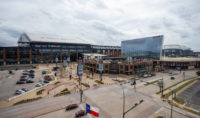Two sports stadiums now under construction required intensive community outreach and careful coordination among the design and construction teams to become a reality.
Albuquerque Public Schools' $35.9-million Community Athletic Facility is the first stadium to be built by the New Mexico school district in more than 40 years. Meanwhile, the University of Arizona is expanding and improving its 84-year-old Lowell-Stevens Football Facility in Tucson.
Welcome to the Neighborhood
For decades, just two stadiums have been serving all of the Albuquerque Public Schools: the aged Milne Stadium, a 1937 New Deal Works Progress Administration project, and the equally outdated Wilson Stadium, built in 1967. Because APS doesn't provide individual stadiums at each high school, these two facilities have accommodated the district's 13 high schools plus St. Pius High School for the past 45 years.
The new facility will eliminate the event-scheduling nightmare the school district faced and advance APS's athletic program with a more conveniently located venue, says Tyler Mason, staff architect for the district.
Located on a 110-acre site at the western edge of Albuquerque, the new facility will include a 7,000-seat artificial turf football arena, four concession buildings, an enclosed press box, a field house with team rooms, conference areas and space for officials.
An adjacent 2,600-seat grass soccer/track and field facility is included, along with parking for 1,000 cars.
But adding this new west-side stadium wasn't popular with everyone. Neighborhood groups immediately objected to the location, fearing increased noise, traffic, lights and crime. To minimize its impact and to maximize community buy-in, the district coordinated with the city's planning department to schedule public meetings with residents.
Based on these discussions, local designer SMPC Architects sited the stadium as far as possible from homes, says Dave Cook, design architect and co-principal for the firm. In addition, the stadium is being built in a bowl configuration to lower the light poles by 20 ft and help mitigate noise by directing it skyward rather than toward residences.
"The sports lighting is designed to focus the beams into a narrow field in order to reduce light spill and avoid direct light glare outside the property line," Cook says. Parking lots will be lighted and have controlled access to discourage loitering and crime.













Post a comment to this article
Report Abusive Comment